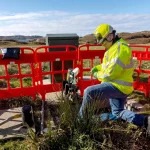Councils Demand Full Fibre Broadband Kitemark for UK New Build Homes
The Local Government Association, which represents roughly 370 councils across England and Wales, has called on UK property developers to introduce a new FTTP Kitemark so that the public can easily see when a new build home is able to access Gigabit capable “full fibre” broadband ISP connections.
The LGA suggests that currently developers “do not have to pay any consideration to its broadband connectivity,” although strictly speaking the current situation should be improving, not least due to the changes that occurred between 2016 and 2017 to address the problem.
Firstly, most of the major home builders (e.g. Home Builders Federation) have now entered into partnerships with network operators (Openreach (BT), GTC and Virgin Media etc.) in order to better facilitate the rollout of fibre optic (FTTP/H) and hybrid fibre (FTTC / HFC DOCSIS) based broadband technologies.
Advertisement
On top of that a new directive from the EU (details), which has also been adopted into UK law, is supposed to mean that all newly constructed buildings (i.e. those that gained permission after the 31st December 2016) are “equipped with a high-speed-ready in-building physical infrastructure, up to the network termination points.” The UK government has also been telling councils to ensure that they factor this into local planning approvals.
However, including support for such services, as per the above paragraph, is only half the battle and the property developer still needs to find a network operator to actually make use of the infrastructure they’ve built (spare cable ducts etc.), which doesn’t always happen. A recent study estimated that around 1 in 4 to 1 in 5 of new build premises are still appearing without provision for even “superfast broadband” speeds of 24Mbps+ (here).
Mark Hawthorne, Chairman of the LGA’s People and Places Board, said:
“Connecting our rural residents to future-proofed, fast and reliable broadband is vital to helping them get on in life and benefit from the advantages that decent digital connectivity can bring.
The standard of digital connectivity we provide to our new build homes should reflect our national ambition to roll out world-class digital infrastructure across the country. Residents will no longer tolerate digital connectivity taking a backseat in developers’ plans.
We call on the Government, homebuilders and the broadband industry to work with us and develop the details of this proposal and give homebuyers the confidence to invest in a new home, knowing they won’t be stuck in the digital slow lane.”
The Government’s new draft of the National Planning Policy Framework aims to help councils’ encourage developers to provide Fibre-to-the-Premises (FTTP/H) connections to existing and new developments, although it does not give them powers to hold developers to account.
Mark Collins, Director Strategy & Policy at CityFibre, added:
“Full fibre is the only infrastructure capable of delivering the reliable gigabit speed services and futureproofed capacity the UK needs. We fully support the LGA’s call for the launch of a FTTP kitemark, which will give full fibre – the gold standard in internet connectivity – the status and recognition it deserves.
Consumers have been misled for decades by advertising practices which allow copper-based broadband products to be advertised as ‘fibre’. The introduction of a kitemark, however, will help consumers know what they are paying for and what standard they should expect.
By improving awareness and increasing demand for that gold standard, consumers, Government, local authorities and industry can collaboratively drive the roll-out of full fibre across the UK, helping it to catch up with the rest of the world.”
It’s worth pointing out that new build home developments often take several years to complete after being granted planning permission, which suggests that a lot of permissions will have been granted before even the new EU guidance came into force.
Advertisement
Nevertheless, introducing an FTTP Kitemark for larger builds (doing this for smaller individual house builds would currently be unworkable for many projects – currently only around 3-4% of the UK can access such a network) would seem to be a reasonable approach, although it won’t necessarily overcome the challenges faced by property developers when seeking to build news homes in more challenging areas, where FTTP/H networks have yet to even remotely reach.
It’s also worth considering that FTTP/H isn’t the only type of network capable of delivering Gigabit broadband speeds. Future DOCSIS 3.1 upgrades (Virgin Media) and even a shorter range G.fast setup or some fixed wireless networks can technically achieve such performance levels. Perhaps basing a Kitemark around one technology isn’t the best approach.
Mark is a professional technology writer, IT consultant and computer engineer from Dorset (England), he also founded ISPreview in 1999 and enjoys analysing the latest telecoms and broadband developments. Find me on X (Twitter), Mastodon, Facebook, BlueSky, Threads.net and Linkedin.
« Which? Scraps Email Service from its Days as a Dialup ISP
Ofcom UK Probe Vonage Over VoIP Network Availability »

















































Comments are closed